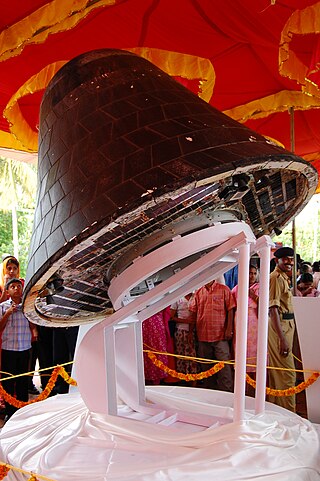Related Research Articles
The Long March rockets are a family of expendable launch system rockets operated by the China Aerospace Science and Technology Corporation. The rockets are named after the Chinese Red Army's 1934–35 Long March military retreat during the Chinese Civil War.

FalconSAT is the United States Air Force Academy's (USAFA) small satellite engineering program. Satellites are designed, built, tested, and operated by Academy cadets. The project is administered by the USAFA Space Systems Research Center under the direction of the Department of Astronautics. Most of the cadets who work on the project are pursuing a bachelor of science degree in astronautical engineering, although students from other disciplines join the project.
The Long March 2C (LM-2C), also known as the Chang Zheng 2C (CZ-2C), is a Chinese orbital launch vehicle, part of the Long March 2 rocket family. Developed and manufactured by the China Academy of Launch Vehicle Technology (CALT), the Long March 2C made its first launch on 9 September 1982. It is a two-stage launch vehicle with storable propellants, consisting of Nitrogen Tetroxide and Unsymmetrical Dimethylhydrazine. The launch vehicle was derived from the DF-5 ICBM.

The Augmented Satellite Launch Vehicle or Advanced Satellite Launch Vehicle, also known as ASLV, was a small-lift launch vehicle five-stage solid-fuel rocket developed by the Indian Space Research Organisation (ISRO) to place 150 kg satellites into LEO. This project was started by India during the early 1980s to develop technologies needed for a payload to be placed into a geostationary orbit. Its design was based on Satellite Launch Vehicle. ISRO did not have sufficient funds for both the Polar Satellite Launch Vehicle programme and the ASLV programme at the same time and the ASLV programme was terminated after the initial developmental flights. The payloads of ASLV were Stretched Rohini Satellites.

This article outlines notable events occurring in 2005 in spaceflight, including major launches and EVAs. 2005 saw Iran launch its first satellite.

The year 2007 contained several significant events in spaceflight, including a Chinese ASAT test, the launches of the US Phoenix and Dawn missions to study Mars and Asteroid belt respectively, Japan's Kaguya Lunar orbiter, and the first Chinese Lunar probe, Chang'e 1.

The Soyuz-FG launch vehicle was an improved version of the Soyuz-U from the R-7 family of rockets, designed and constructed by TsSKB-Progress in Samara, Russia. Guidance, navigation, and control system was developed and manufactured by "Polisvit" Special Design Bureau.

Several significant events in spaceflight occurred in 2009, including Iran conducting its first indigenous orbital launch, the first Swiss satellite being launched and New Zealand launching its first sounding rocket. The H-IIB and Naro-1 rockets conducted maiden flights, whilst the Tsyklon-3, Falcon 1 and Ariane 5GS were retired from service. The permanent crew of the International Space Station increased from three to six in May, and in the last few months of the year, Japan's first resupply mission to the outpost, HTV-1, was conducted successfully.

This comparison of orbital launch systems lists the attributes of all individual rocket configurations designed to reach orbit. A first list contains rockets that are operational or in development as of 2022; a second list includes all retired rockets. For the simple list of all conventional launcher families, see: Comparison of orbital launchers families. For the list of predominantly solid-fueled orbital launch systems, see: Comparison of solid-fueled orbital launch systems.
The Feng Bao 1, also known as FB-1, was a Chinese carrier rocket launched between 1972 and 1981. It was replaced by the nearly identical Long March 2, which had been developed at the same time for political reasons related to China's Cultural Revolution.
JCSAT-4A, designated JCSAT-6 before launch, is a Japanese geostationary communications satellite which is operated by JSAT Corporation. It is positioned in geostationary orbit at a longitude of 124° East, from where it is used to provide broadcasting and corporate network communications to Japan.

This article compares different orbital launcher families. The article is organized into two tables: the first table contains a list of currently active and under-development launcher families, while the second table contains a list of retired launcher families.

This article documents notable spaceflight events during the year 2019.

Notable spaceflight activities in 2017 included the maiden flight of India's Geosynchronous Satellite Launch Vehicle Mark III on 5 June and the first suborbital test of Rocket Lab's Electron rocket, inaugurating the Mahia spaceport in New Zealand. The rocket is named for its innovative Rutherford engine which feeds propellants via battery-powered electric motors instead of the usual gas generator and turbopumps.
Kosmos 1409 was a Soviet US-K missile early warning satellite which was launched in 1982 as part of the Soviet military's Oko programme. Kosmos 1409 replaced Kosmos 1217 as part of the Oko constellation of satellites and covered the plane 2 - 317° longitude of ascending node.
USA-38, also known as GPS II-2 and GPS SVN-13, was an American navigation satellite which formed part of the Global Positioning System. It was the second of nine Block II GPS satellites to be launched, which were the first operational GPS satellites to be launched.
References
- 1 2 3 4 Kyle, Ed. "China Launch Vehicle Flight History - Comprehensive Orbital Failure List". Space Launch Report. Archived from the original on 6 June 2019. Retrieved 6 June 2019.
- 1 2 "The Cox Report: Chapter 5". The Washington Post. 25 May 1999. Archived from the original on 1 December 2017. Retrieved 14 December 2017.
- ↑ "CZ-2E Space Launch Vehicle". GlobalSecurity.org. Archived from the original on 1 December 2017. Retrieved 19 November 2017.
- ↑ "Ku Transponder Shortfall Prompts AsiaSat Claim". Aviation Week & Space Technology. 23 September 1996. Archived from the original on 1 December 2017. Retrieved 19 November 2017.
- ↑ Lan, Chen. "Mist around the CZ-3B disaster, part 1". The Space Review. Archived from the original on 1 December 2017. Retrieved 18 January 2014.